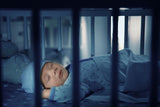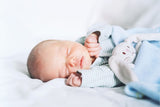How to Dry Newborn Clothes?
Interested to know how to dry newborn clothes? Keeping your baby's clothes clean and fresh is essential to caring for your little one. Still, it can also cause stress and confusion when you're unsure how to do it properly.
When drying newborn baby clothes, you should be gentle and careful with delicate fabrics while ensuring everything is clean and ready to wear.
In this article, we'll walk you through everything you need to know about drying newborn clothes like a pro, with detailed tips to help make laundry day a breeze.
Let’s jump right in!
How to Dry Newborn Clothes
Drying your newborn's clothes is essential to keep them clean and comfortable. But with so many different fabrics and sizes, knowing how to dry newborn clothes can be tricky. Luckily, simple tips and tricks can help make the process a breeze.
At Bitsy Boutique, we understand how important it is to keep your baby's clothes looking and feeling their best. That's why we offer a collection of trendy newborn baby girl clothes on our website, designed for your little one's comfort. From cozy sleepers to cute onesies, we have everything you need to keep your baby looking and feeling its best.
From a dinosaur hooded onesie to a striped romper – newborn baby girl clothes come in various shapes and fabrics. That said, let’s get onto the tips!

Source: shutterstock.com / Photo Contributor: Melinda Nagy
Use low heat on the dryer to prevent shrinking
High heat can cause the fabric's fibers to break down, leading to shrinkage and damage to the clothes. This is especially important for clothes made of natural fibers such as cotton, which can be more susceptible to shrinking.
Using a low heat setting, you can ensure that your baby's clothes are dried gently and without damage, helping them last longer and be in great condition. The safest way, however, is to air dry them. This brings us to the next topic.
Let the clothes air dry
Make sure you avoid the dryer (unless really necessary) and air dry the baby clothes instead. This method is gentle on the fabric and ensures that there is no risk of shrinkage or damage to the clothes. Plus, it's a cost-effective way to dry your baby's clothes and is environmentally friendly too!
This method is perfect for delicate fabrics like muslin or lace, which can be easily damaged in the dryer. That said, if you're looking for a gentle and eco-friendly way to dry your baby's clothes, air drying is a great option!
Use plastic or wooden clothespins
Using plastic or wooden clothespins when air drying baby clothes is important for several reasons. First, they are gentle on the delicate fabric of baby clothes, unlike metal clothespins which can leave rust stains or cause damage.
Second, they are less likely to leave marks or indentations on the clothes, which can be a concern when trying to keep baby clothes looking nice. Finally, plastic or wooden clothespins are less likely to snag or tear the fabric, ensuring the clothes last longer.
Don't burden the drying rack
Overcrowding the rack can cause the clothes to take longer to dry and can even cause them to become misshapen or wrinkled.
It's important to remember that baby clothes are often small and delicate, so they require more care and attention when drying. By giving them enough space to air out and dry properly, you'll help ensure that they remain in good condition and last longer.
Plus, you'll avoid the frustration of having to rewash or iron clothes that didn't dry properly the first time around.
Fold the clothes nicely
Once your baby's clothes are dry, fold them neatly to keep them in good condition. By taking the time to fold each item carefully, you'll make it easier to find what you need when dressing your little one and help prevent wrinkles and creases from setting in.

Source: shutterstock.com / Photo Contributor: Pixel-Shot
Don't store the clothing in a plastic container
Storing air-dried baby clothes in plastic containers and bags might seem like a good idea, but it can lead to mildew growth and unpleasant odors. Plastic doesn't allow air to circulate, and moisture can easily accumulate, creating a breeding ground for bacteria and mold.
Instead of plastic containers, use breathable storage options like hanging the clothes directly in the closet. This will ensure your little one's clothes stay fresh and clean, ready for their next use.
Knowing how to dry newborn clothes is key to keeping your baby's delicate skin safe from irritants. While air drying is essential, storing the clothes correctly after drying is equally important.
Washing and Care Tips That Might Be of Help
Wash new clothing items before using them for the first time
Washing new clothes before using them is crucial, especially for newborns, as it helps to remove any harmful chemicals or dyes used during manufacturing. These substances may cause skin irritation, rashes, or other allergic reactions, which can harm a newborn's delicate skin.
Additionally, new clothes may contain dust, dirt, or other debris accumulated during storage or shipping. By washing new baby clothes, you are not only keeping your baby's skin safe and healthy but also making the clothes more comfortable to wear.
Always check the care label
The care label is your best friend when caring for your baby's clothes. It's essential to check the label before you dry your newborn's clothes to ensure you follow the manufacturer's instructions.
The label will provide you with information such as the appropriate temperature to use and whether the garment can be tumble-dried or should be air-dried.
Following the instructions on the label will help ensure that your baby's clothes stay in their ideal condition and will also help prolong their lifespan.
Separate the clothes by color and material
Separating the clothes helps prevent any bleeding or fading of colors and protects delicate fabrics from damage. Separating clothes by color also ensures that whites stay bright and free from any color transfer.
Separating the clothing by its material type is also important because different materials have different drying times and care requirements. Separating them can help ensure your baby's clothes are dried thoroughly and without damage.
So be sure to take extra time to sort your little one's clothes before drying them - it's worth the effort to keep them looking their best!
Use a stain remover before washing
Stains can be tough to remove, especially if left to set in. With a good stain remover, you can keep your baby's clothes looking clean and fresh, no matter how messy they are.
Using a baby-safe stain remover can help remove stubborn stains without damaging most baby clothes' delicate fabric.
Simply apply the stain remover to the affected area and let it sit for a few minutes before washing.
Avoid mixing baby clothes with adult clothes
Adult clothes tend to be made of heavier fabrics that can damage delicate baby clothes, and they may also be washed with stronger detergents or fabric softeners that can irritate your baby's skin.
To avoid potential problems, washing and drying your baby's clothes separately from your own is best.
This will ensure that their clothes are washed and dried with gentle products and handled with care, helping to keep them in excellent condition for as long as possible.
Don't burden the washing machine
Overloading the machine can damage delicate fabrics and lead to poor results. Additionally, the clothes may dry unevenly or may come out wrinkled.
To avoid these problems, it's best to wash small loads of baby clothes at a time and follow the manufacturer's recommendations for load size.
This way, you can ensure the clothes are properly cleaned and dried without any issues.

Source: shutterstock.com / Photo Contributor: New Africa
Use a baby laundry detergent
Baby laundry detergents are specially formulated to be gentle on delicate skin, free from harsh chemicals and fragrances that can irritate your baby's skin. Regular detergent may leave residue on your baby's clothes, leading to skin irritation or an allergic reaction.
Additionally, baby detergents are typically designed to work well with cold water, which can help protect the fibers of your baby's clothes and keep them looking new.
Conclusion
We are happy if these tips have helped you learn how to dry newborn clothes and how to store them properly.
The drying process is equally important as washing, so ensure to not mix newborns’ with adults’ clothes in the washing/drying machine. The overall care for your newborn clothes will keep them clean of dirt and bacteria that may harm the baby’s skin.






